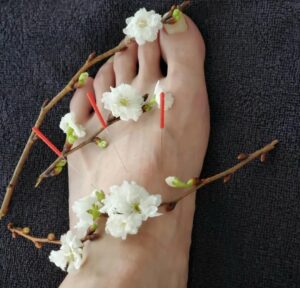肉離れ
torn muscle
肉離れは、正式には筋挫傷と呼ばれます。運動を行うなかで、急に無理な動作をした場合に発生する、筋膜や筋繊維の損傷や断裂のことを言います。筋肉が裂けたり破れたりすることを筋断裂といいますが、筋断裂のうち範囲が部分的なものを一般的に肉離れと呼びます。発症すると患部に激痛が走ります。筋肉が断裂した瞬間に「プチッ」という音が聞こえることもあります。痛みのある部位をよく観察すると、皮膚にくぼみや変色があることもあります。肉離れは、筋肉の強い収縮とともに、逆に強く引き伸ばされるような方向の力が加わったときに起こりやすいです。急なダッシュやストップ、ジャンプからの着地などのタイミングで多発します。筋肉疲労の蓄積、加齢、ウォーミングアップの不足などは、肉離れを引き起こす要因です。運動中に肉離れや打撲、捻挫などのケガをした場合は、基本的には急性期は冷やし、慢性期は温めます。急性期の受傷した直後は、炎症反応を起こして腫れや痛みが強いため、患部を冷やして血流を抑える必要があります。安静にし、冷却して、発熱を抑え、患部を圧迫し、患部を心臓よりも高い位置にすることで、内出血や炎症を抑える応急処置(RICE処置)が有効です。急性期が約2〜3日で終わり、慢性期に移行します。慢性期になると炎症は治まりますが、痛めた部位が疲労して筋肉が硬くなり、血流が滞った状態になります。その結果、酸素や栄養が行き届かなくなり、腫れや痛みにつながります。この時期には、患部を温めて血流を促し、硬くなった筋肉をほぐすことが大切です。急性期にも慢性期にも使用できるのが、超音波、マイクロカレントやTENSを用いた電気刺激療法です。RICE処置後に用いることで、運動神経や知覚神経に電気刺激を与えて、筋肉を収縮・緩和させ、痛みを和らげる効果が期待できます。肉離れが起こりやすい部位は競技によって異なりますが、ハムストリングス、や大腿四頭筋、内転筋、腓腹筋などです。ケガは完治までに数日から数週間、程度によっては1ヶ月以上かかることもあります。また、超音波療法も、超音波の刺激で組織を活性化して、自然治癒力を高める働きがあり、肉離れや打撲、捻挫などの回復を早める効果が期待されています。また、鍼灸治療も、血行が促進されて発痛物質が排出されるため、痛みの緩和に有効です。
A torn muscle is officially called a muscle sprain. It is an injury or tear of fascia or muscle fibers that occurs during exercise when a sudden and forceful movement is made. A tear or rupture of a muscle is called a muscle tear, and a partial muscle tear is generally called a torn muscle. When it develops, the affected area is in extreme pain. A "popping" sound may be heard at the moment the muscle is torn. Close inspection of the painful area may reveal dimpling or discoloration of the skin. A torn muscle is more likely to occur when a force is applied in a direction that causes a strong contraction of the muscle as well as a strong stretch in the opposite direction. They occur frequently during sudden dashes, stops, and landings from jumps. Accumulation of muscle fatigue, aging, and inadequate warm-up are factors that can cause muscle separation. When an injury such as a separated flesh, bruise, or sprain occurs during exercise, the patient should basically cool down during the acute phase and warm up during the chronic phase. Immediately after an acute injury, the affected area should be cooled to reduce blood flow because of the inflammatory reaction, swelling and pain. Rest, cooling, and first aid (RICE) treatment is effective in reducing internal bleeding and inflammation by reducing fever, compressing the affected area, and elevating the affected area above the heart. The acute phase ends in about 2 to 3 days, and the patient moves into the chronic phase. In the chronic phase, the inflammation subsides, but the injured area becomes fatigued, the muscles become stiff, and blood flow is blocked. As a result, oxygen and nutrients cannot reach the area, leading to swelling and pain. During this period, it is important to warm the affected area to stimulate blood flow and relax the stiffened muscles. Electrical stimulation therapy using ultrasound, microcurrent or TENS can be used in both the acute and chronic phases; when used after RICE treatment, electrical stimulation of the motor and sensory nerves can be used to contract and relax the muscles and relieve pain. The areas most prone to muscle separation vary by sport, but include the hamstrings, quadriceps, adductor muscles, and gastrocnemius muscles. Injuries can take days to weeks to fully heal, and even a month or more depending on the extent of the injury. Ultrasound therapy is also expected to help speed recovery from separated muscles, bruises, and sprains, as ultrasound stimulation activates tissues and enhances natural healing power. Acupuncture and moxibustion therapy is also effective in relieving pain, as it promotes blood circulation and expels pain-producing substances.



